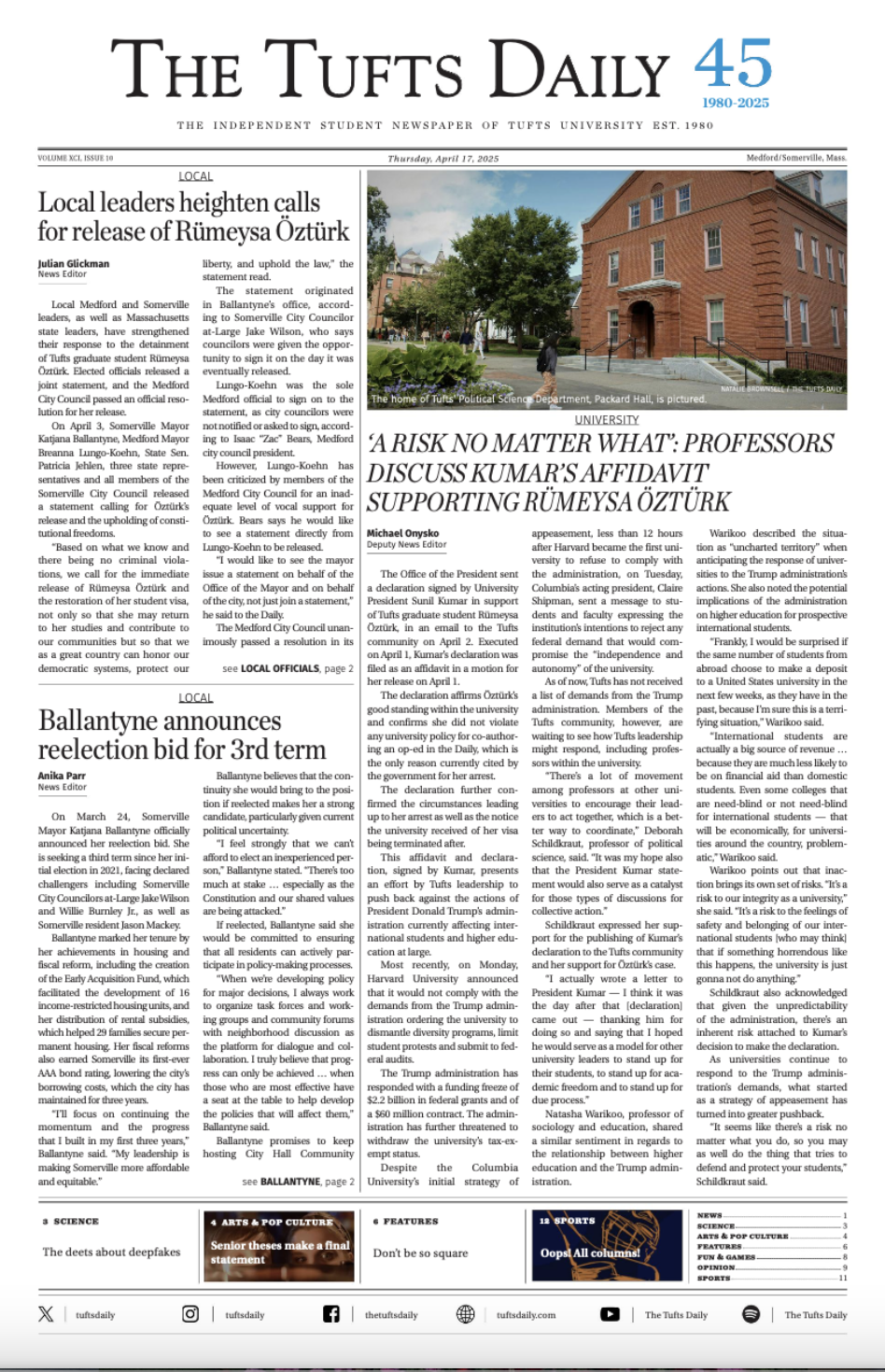Dear reader, I really didn’t want to think about student housing at Tufts ever again. I really didn’t. When I graduated two years ago, I left behind not only my lottery and off-campus housing woes, but also a little leftist organization calledTufts Housing League. We aimed to raise consciousness among fellow students that, among other things, Tufts was a driving engine of local gentrification and that landlords are no good and should be fought by tenants as a unified and militant class. Our rallying cry was simply “build a dorm” — to end the displacement of area residents by Tufts students with nowhere else to go, and to undercut the off-campus slumlords who kept raising rent while letting their buildings fall apart.
The administration didn’t listen, and in the past two years, students have paid the price.
The plaster facade of Tufts’ fragile housing system first crumbled, and then fell quite spectacularly, when confronted with the admittedly world-shaking exigency of the first global pandemic to fully overtake the modern world. Being in close proximity to others could kill you now! Suddenly, the master housing plan of stuffing as many undergrads as possible into forced doubles, triples and quadruples seemed to be the wrong move. And so, finally faced with the existential need to create some extra quarantining space for its COVID-19-positive students, the administration swallowed its pride and subjected its president to one of the most embarrassing fates from which a well-heeled member of the academic elite can suffer: a trailer park in the university’s backyard.
The particularities of the COVID-19 housing problem would have certainly been hard for administrators to predict. But nevertheless it exposed, as emergencies often do, underlying vulnerabilities of the system they had $2 billion to maintain. If they had simply fronted the money or even raised new funds for a new high-density dorm as students had been asking for, the school would have had more space to adapt to the situation nimbly and safely. Instead, students got shuffled into dark, dank isolation wards, or were exposed to community transmission in their off-campus apartments.
A year later, students are once again paying for Tufts’ housing inaction, and the administration can’t even blame a new civilization-altering superbug this time around. Doubling down on its habit of admitting more students every year, the administration let in a record number of new Jumbos for fall 2021, again without building any significant new dorm space to lodge them. And so, Class of 2025, welcome to Tufts! Well, not Tufts … the Hyatt Place Hotel in Medford. But don’t worry! It’s only a 30 minute walk through one of the metro area’s most dangerous intersections to all your classes and friends — 10 minutes by our ever-reliable shuttle service — and there’s a pool! (Actually, can someone check if students will be allowed to use the pool? If so, that’s extremely rad, and a million times better than living anywhere on campus).
Pool or not, this is not the college experience Tufts advertises for $81,700 a year. It is also not a long-term solution to the displacement of students into an overheated, overpriced off-campus housing market, and the ensuing displacement of area residents out of their own neighborhoods. The lack of adequate student housing at Tufts is a long-term structural problem that needs a serious remedy, and quick.
Before I go back to my somewhat-adult life where I have a demanding job and don’t have to worry about any of this anymore, I’ll offer the solution I proposed to the administration when THL had our handful ofdead-end meetings with them a few years ago. To start, let’s consider four basic facts:
- Tufts needs to build a big, tall dorm, somewhere on campus.
- Building a new building costs a good deal of money, which Tufts has very little of (as I’m told the $2 billion endowment functions primarily as a non-liquid, risk-tolerant hedge against gettingbamboozled once more by the next Bernie Madoff).
- The Green Line Extension is almost complete, only a decade or so behind schedule, bringing its terminus and a crowd of commuters right to Tufts’ doorstep.
- Whenever my sleep-deprived immune system or psyche required the services of a pharmacist while I was a student at Tufts, I had to drag my boots 20 minutes through snow and rain down to the CVS in Davis, since it was apparently the closest place I could get the medications needed to continue justifying my enrollment.
These challenges present Tufts with what is, in my opinion, a great opportunity: Build that new dorm you’re finally eyeing in the parking lot behind Hill Hall, right next to Dowling Hall. Make it as tall as Dowling, seven stories, to fit in as many rooms as possible. And help finance it by leasing out ground-floor retail space to an anchor chain like CVS, along with some other tenants, that will serve not only a pharmacy-desperate student population but also all the commuters pouring through the new T stop. This is what’s known in the city-planning world as “transit-oriented development” — harnessing the economic opportunity of thousands of transit riders to densify residential and commercial land use along major corridors like the Green Line. If you do this, Tufts administrators, transit-oriented teens will thank you. And so will every Tufts student who has ever had to live in a forced triple, or a quarantine shipping container, or a mold-ridden, off-campus house that they and their family can’t really afford or, God forbid, an unregulated fire-trap unit above a garage.
Please build this dorm as soon as possible so I can get on with my life and finish the spreadsheets I’ve been avoiding at work. Also feel free to name it after me, using the CVS idea for free in lieu of the standard multimillion-dollar donation. I don’t mind.
Shane Woolley graduated from Tufts in 2019. Shane can be reached at shwoolley@gmail.com.






